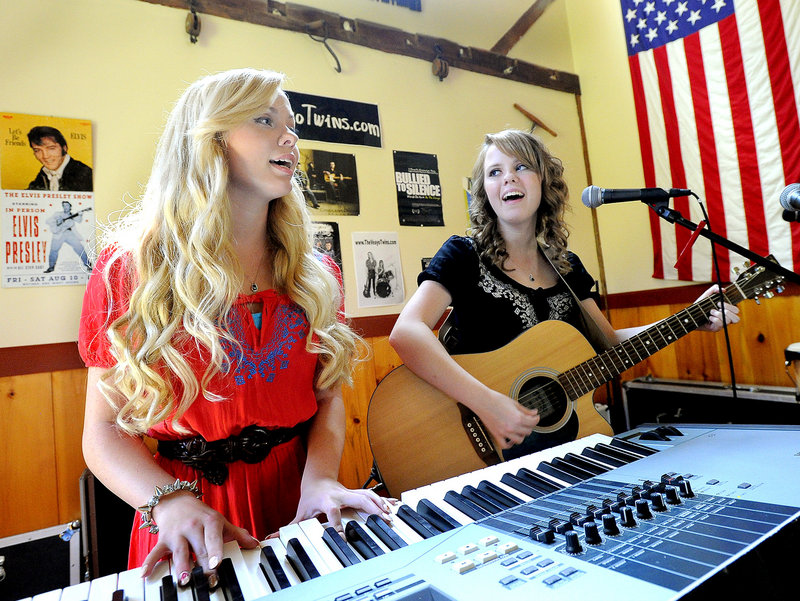The days before school began each fall were often the worst for Kristen and Katherine Veayo.
They didn’t sleep well. They didn’t eat. They were balls of anxiety.
There was always the hope that a new year might bring change, but that hope clashed with the unnerving reality that kids can be cruel.
“It got so bad, I couldn’t eat in the lunchroom,” Kristen said. “I used to go to the nurse’s office just to hide.”
The Veayos, identical twins from Winthrop, were not part of the “in” crowd at their school — a school they said put a premium on athletics, something they had no interest in.
But they had another strike against them, too. They stuttered. Often the only people who could understand them were each other. And that was just enough fuel for classmates.
“Sometimes, if you spoke up, it just gave them more ammunition,” Katherine said.
Thousands of Maine children went back to school last week, and thousands more will begin the 2013-14 year after the holiday weekend.
As many as one in three in Maine will be bullied at some point, and the bullying will be as varied as the children themselves.
Education experts say bullying has always been a problem in schools, but technology and social media have changed the game. Now, bullying doesn’t have to be overtly physical or confrontational. It can be done behind the keys of a computer or the touchscreen of a smartphone.
Maine updated its laws last year to better address bullying in schools, to add language about electronic bullying, or cyberbullying, and to give school officials more jurisdiction on bullying activity that happens outside school hours and off school grounds.
“I think this is the first year that we will actually see impact from that law,” said Ali Vander Zanden, political director for Equality Maine, an advocacy group for lesbian, gay, bisexual and transgender Mainers that worked to help pass the anti-bullying bill.
The changes have created a more uniform policy statewide and have increased awareness of the problem, but administrators say putting new policies in place is only half the battle.
James Hodgkin, superintendent of RSU 4 in Wales, Sabattus and Litchfield, said changing the culture within each school is equally important.
“You have to address any complaints or allegations because to bury your head in the sand is too dangerous,” he said. “But our real goal has been to spend more time on how we want kids to treat each other, not on how we don’t want them to treat each other.
“A high percentage of kids are not bullies. So how do you empower them to help eliminate that small group of students that are?”
The Veayo sisters, who turned 18 last week and started their senior year at Hall-Dale, say they are no longer bullied, but they don’t want others to go through what they did. That’s why they speak out.
“The worst thing you can do is not tell someone,” Kristen said.
EARLY PROBLEMS
For Kristen, it started in elementary school. She used to avoid speaking to classmates. She would spend a lot of time in the bathroom just hiding.
It only got worse once she got to middle school.
She said she tried talking to teachers, but they effectively didn’t do anything. After a while, she stopped trying.
The problem didn’t go away, though. Her classmates continued to make fun of her stutter. Katherine sometimes stepped in to defend her sister, but that only brought ridicule her way, too.
They were often pulled out of class for speech therapy.
“Other kids always knew why,” Katherine said.
Katherine said she stopped speaking up, too, and, instead tried to make everyone around her happy.
Kristen began to numb the pain by cutting herself, a common outlet for teenagers.
“I couldn’t cry and that was a way to release the same endorphins,” she said.
Steve Veayo, the girls’ father, said he had no idea how bad things had gotten.
Middle school often is the time when students are most susceptible to bullying behavior. Lots of changes happen during middle school years, the biggest of which, of course, is puberty.
“And they are not always the most sophisticated in dealing with peer relationships,” said Walter Wallace, principal at Brunswick Junior High.
The most recent Maine Integrated Youth Health Survey, conducted in 2011 by the Department of Health and Human Services, found that 48 percent of middle school students reported being bullied on school property. That dropped to 24 percent for high school students.
Females were slightly more likely to be bullied than males, although almost twice as likely to be bullied electronically. The 2011 survey found that 40 percent of middle school girls reported being bullied, compared to 22 percent of middle school boys. For high school students, 26 percent of girls and 14 percent of boys said they had been cyberbullied.
The new law that went into effect last year added teeth to existing law by requiring schools to investigate all suspected cases and to keep records of incidents. Each school also now has a dedicated “bullying czar.”
“The biggest benefit is that we can track patterns,” Wallace said. “For instance, if we see a large number of incidents reported in the cafeteria, we can beef up supervision there.”
Wallace said educators have been taught that the worst thing they can do is ignore or minimize claims of bullying.
“Not everything falls into bullying. We try to delineate between bullying and just normal conflict, but it’s sometimes a blurry line,” he said.
The Veayos said they were bullied on and off through middle school and into high school. After their freshman year, though, they finally looked for a change. They switched schools.
Both girls said they have no interest in bad-mouthing their former school, but said the switch was the right decision for them.
“I’m sure there is bullying going on here, too,” Katherine said. “But it seems like a more accepting place. And anytime something does happen, it gets addressed pretty quickly.”
PRESSING FOR CHANGE
As Maine works to implement the new law passed in 2012, some want to take it a step further.
A bill this past session, L.D. 1233, sponsored by Sen. Margaret Craven, D-Lewiston, sought to establish a separate crime of cyberbullying. The bill failed to advance out of the Education and Cultural Affairs Committee, but it continued the discussion.
Another area of concern is bullying of lesbian, gay, bisexual and transgender individuals. In recent years, there has been much awareness and acceptance of sexual orientation in schools, but that also has given bullies another tool, said Vander Zanden of Equality Maine.
The Maine Integrated Youth Health Survey does not contain data about gay, lesbian, bisexual or transgender students, but a 2011 study by the Gay, Lesbian & Straight Education Network suggests that LGBT students are much more likely to be bullied or harassed.
Fifty-seven percent of Maine LGBT students surveyed said they had been bullied electronically. Ninety percent said they had heard homophobic slurs used regularly in schools.
But things are changing.
The Maine Principals’ Association adopted a new policy this year that allows transgender students to participate in athletics in whatever gender they identify with. Additionally, the case of Nicole Maines, a transgender student from Orono who sued her school district for requiring her to use the staff bathroom, has reached the state’s highest court and could lead to statewide policy changes.
“We still have a lot to do, of course, but we’ve made great strides,” Vander Zanden said.
The biggest need, now, she said, is to give teachers and administrators more professional development and training opportunities. They need to know how to stay one step ahead of the students, especially in the electronic bullying area, where young people often are more tech savvy than their elders.
Hodgkin, the RSU 4 superintendent, said increased awareness has led to an increase in the number of bullying reports in his schools. They are not all cases of bullying, he said, but each claim is an opportunity to move the discussion forward.
“I don’t think it ever goes away,” he said. “But you can always get better and these new laws have opened a lot of eyes.”
The worst ending in bullying cases, of course, is suicide.
Suicide is the third leading cause of death among young people, resulting in about 4,400 deaths per year, according to the U.S. Centers for Disease Control and Prevention.
For every suicide among young people, there are more than 100 suicide attempts. About 14 percent of high school students have considered suicide, and nearly 7 percent have attempted it.
Every year there are high-profile suicides of young people who had been bullied in the past.
Kitty McGuire, a 13-year-old from Troy, took her own life in March. Family members have said the girl was the victim of bullying and that it was a factor in her suicide, although the Waldo County Sheriff’s Department has disputed that.
Kristen Veayo never tried suicide. But her cutting got so bad that she had to leave school and spend time in a hospital.
She said the lesson she learned was to find another outlet.
She and her sister have always been interested in music and that became their biggest source of comfort. They perform as a pop-rock duo all over New England. Katherine plays piano, keyboards and drums. Kristen plays guitar, writes lyrics and sings. Her stage voice sounds older than 18, and it strips away any signs of her stutter.
The Veayos are good, too. Last year, they beat out 11 other high school bands to win a contest hosted by the Maine Academy of Modern Music. This year, they were nominated for Best in State by the New England Music Awards.
A lot of their song lyrics address their experiences. The older they have gotten, they said, the easier it has become to speak out.
“I used to not want to talk about it,” Kristen said. “But if it helps. I don’t want other kids going through what I did.”
Eric Russell can be contacted at 791-6344 or at:
erussell@pressherald.com
Twitter: @PPHEricRussell
Send questions/comments to the editors.




